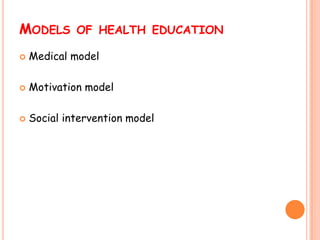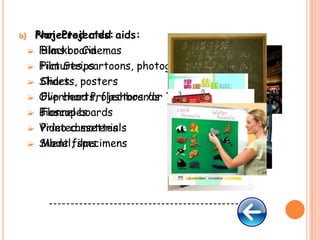Oral Health Education and Health Promotion
- 3. INTRODUCTION The process of imparting information about health in such a way that the recipient is motivated to use that information for the protection or advancement of his own, his family’s or his community’s health.
- 4. DEFINITION “Health education or literacy represents the cognitive and social skills which determine the motivation and ability of individuals to gain access to, understand and use information in ways which promote and maintain good health.” -WHO Health promotion Glossary, 1998
- 5. OBJECTIVES Informing people (Cognitive objective) Motivating people (Affective objective) Guiding into action (Behavioral objective) FINAL GOAL
- 6. APPROACHES TO ACHIEVE HEALTH 1. Regulatory or legal approach 2. Administrative or service approach 3. Educational approach 4. Primary health care approach
- 7. MODELS OF HEALTH EDUCATION Medical model Motivation model Social intervention model
- 8. PRINCIPLES 1. 2. 3. 4. 5. 6. OF HEALTH EDUCATION Credibility Interest Participation Motivation Comprehension Reinforcement 7. 8. 9. 10. 11. 12. Learning by doing Known to unknown Setting an example Good human relations Feedback Community leaders
- 9. STAGES IN THE ADOPTION OF NEW IDEAS AND PRACTICES Trial Evaluation Interest Awareness Unawareness
- 10. HEALTH COMMUNICATION “a key strategy to inform the public about health concerns and to maintain important health issues on the public agenda. The use of the mass and multimedia and other technological innovations to disseminate useful health information to the public, increases awareness of specific aspects of individual and collective health as well as importance of health in development.” -WHO Health promotion Glossary, 1998
- 11. EDUCATIONAL AIDS USED IN HEALTH EDUCATION Main constituent of the armamentarium of the health education process. Auditory aids Visual aids A combination of audio-visual aids.
- 12. METHODS OF HEALTH EDUCATION 1. INDIVIDUAL APPROACH 2. GROUP APPROACH 3. MASS APPROACH
- 14. DEFINITION “the process of enabling people to increase control over, and to improve their health”. -Ottawa Charter for Health Promotion, 1st International Conference on Health Promotion, Ottawa, 21-Nov-1986
- 15. Five priority action areas for health promotion: 1. Building healthy public policy 2. Creating supporting environments for health 3. Strengthening community action for health 4. Developing personal skills 5. Re-orienting health services
- 16. APPROACHES TO HEALTH PROMOTION 1. Preventive 2. Behavior change 3. Educational 4. Empowerment 5. Social change
- 18. Makes use of law made by govt. to protect health of public Examples : Epidemic Disease Act Pollution Act Food Adulteration act Environmental Act Drawbacks : Applicable only in limited situations May not alter the behavior of the individual These laws are not democratic since they interfere with an individual’s personal choices --------------------------------------------
- 19. It intends to provide all the heath facilities to the people with the hope that they will use it. Drawbacks: It becomes a failure if the service is not based on the felt needs of the people. --------------------------------------------
- 20. Most effective means for achievement of changes in the health practices and life-styles of the community. Learning new “facts”, “unlearning” wrong information. Results may be slow, but they are permanent and enduring. Sufficient time should be allowed. --------------------------------------------
- 21. Involves full participation and active involvement of the people. Based on the principles of primary health care Community participation --------------------------------------------
- 22. a) b) c) d) e) f) Megaphones Public addressing systems or microphones Gramophone records and discs Tape recorders Radios Sound amplifiers Can also be used for entertainment and mass communication. --------------------------------------------
- 23. b) a) Non-Projected Projected aids: aids: Films or Cinemas Blackboard Film Strips Pictures, cartoons, photographs Slides posters Charts, Overhead Projectors /or Transparencies Flip charts, flashboards Bioscopes Flannel boards Video cassettes Printed materials Silent films Model, specimens --------------------------------------------
- 24. Creates a better presentation…. They include: Televisions Tape and slide combinations Video cassettes players and recorders Motion pictures or cinemas Multimedia computers Also include traditional media Folk dances Folk songs Puppet shows Dramas --------------------------------------------
- 25. Advantages: Can be done in a dentist’s consultation room. Discussion, argument and persuasion of an individual to change his behavior is possible. There is opportunity for the individual for asking Disadvantages: questions and clearing doubts. Only a small no. can benefit Health education is given only to those who come in contact with the dental surgeon or with public health personnel -------------------------------------------- ----
- 26. a. b. c. d. e. f. g. h. Chalk and talk (lectures) Symposium Group Discussions Panel discussions Workshop Conferences or seminars Role playing/socio dramas Demonstrations --------------------------------------------
- 27. a) b) c) d) e) f) g) h) i) Television Radio Newspapers/press Documentary films Posters Health exhibition Health magazines Information booklets Internet --------------------------------------------


























